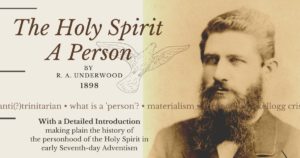(Podcast Version – Follow/Subscribe)
We recently finished celebrating the Feast of Unleavened Bread and, as part of keeping the feast, we published some new studies. In this post, I’ll be telling you a bit about each study and then I recommend following the links to read or watch them in full.
Project 1: The Two Flood Stories in Genesis (video and podcast)
The first study is by Ed and Mary Zebrowski, published on Sabbath School with Branch Davidians, which is both a YouTube channel and a Podcast. The study is called The Two Flood Stories in Genesis. Have you ever noticed that in Genesis 7, there are two places that say two different things about the number of animals that boarded Noah’s ark? In verses 1-5 it says that there were seven pairs of all the ritually pure animals while there were only two of each impure animal. In contrast, in verses 8 and 9, it specifies that from both the pure and the impure animals, there were only two of each! This is one of those things that most of us probably notice and think, “That’s weird,” but then we don’t know what to do with it so we just keep reading. But what you might not have noticed is that this isn’t the only weird thing like this in the Genesis flood story. Thankfully, the reason for these oddities isn’t a mystery. The answer is actually known, even though most people don’t know it. But my purpose here isn’t actually to explain the answer; it’s to point you to where you can learn it. So again, check out The Two Flood Stories in Genesis.
Project 2: Why Vaccine Mandates are Not an Evil Infringement on Religious Liberty

Alright, the next thing is an article by Melissa DiLernia answering the question, “Why don’t you think vaccine mandates are an evil infringement on religious liberty?” This is one of those subjects that people often come to with preconceived ideas, and it’s a subject people can get very passionate about. Yet, one of the most basic principles any lover of truth must embody is a willingness to consider things from a fresh perspective – to put aside preconceived ideas and investigate a different view without prejudice. And while it’s natural to become passionate about matters of great consequence, we need to keep our passion subservient to reason. It’s only by genuinely embodying this calm, rational, teachable attitude that we can have any legitimate claim to being a lover of truth.
It’s all too easy to adopt an opinion and then to accept or reject what someone else says based on whether or not it agrees with your opinion. Again, that’s easy. Or, to state it with greater frankness, it’s intellectually lazy. An approach that is far more consonant with a love for truth is to consider the reasons someone gives for holding a certain position and to evaluate whether those reasons hold up to valid logic and solid evidence. In other words, when someone states a position contrary to what you’ve thought up until now, don’t allow yourself to become prejudiced. Be willing to change your mind in light of new evidence or new reasons.
Melissa’s article gives reasons as to why vaccine mandates are not an evil infringement on religious liberty. I hope you’ll read the article and unbiasedly consider the reasons. If you already agree that vaccine mandates are not an evil infringement on religious liberty, I still think you’ll benefit from reading the article. It’s very concise and will likely help you refine your own thoughts on the subject.
Project 3: How Could “The Invisible Christ” Be a Female?

The next article is by Teresa Wilde. (In case you’re new to the blog, Teresa is my wife and also my closest co-worker.) Her article is answering a question from a Davidian context. I’ll briefly explain that context so that you can read the article and understand it more fully even if you’re not a Davidian. So first, for those of you who don’t know, when I say Davidian, I’m referring to a message and movement that started within the Seventh-day Adventist church in 1929 with the teachings of a man named Victor Houteff. His message is known as the Davidian message and it’s also known as the Shepherd’s Rod. Most SDAs aren’t really familiar with Houteff’s message, but the SDA church as a body is generally opposed to it. Shortly after Victor Houteff died in 1955, a Davidian named Benjamin Roden started teaching a new message building on Houteff’s message. Davidians who accepted Ben Roden’s message became known as Branch Davidians. Most Davidians, though, didn’t become Branch Davidians but instead followed Florence Houteff, Victor Houteff’s wife. Florence predicted that certain prophecies would be fulfilled in 1959 and when her predictions failed the Davidians who had followed her soon split into a number of factions, which have subsequently split into further factions so that there are well over a dozen Davidian groups today. And most Davidians today are as unfamiliar with the Branch Davidian message as most SDAs are with the Davidian message.
When Davidians encounter Branch Davidian teachings, it’s normal for them to have questions. Teresa’s article is a response to just such a question. To understand this specific question, there’s one other thing I should briefly explain. Victor Houteff’s message didn’t have much to say on the Godhead, that is, on subjects like the Trinity and the nature of the Holy Spirit, and the relationship between the Father and the Son. Because of this, the Godhead simply isn’t a major topic for most Davidians. The Davidians I’ve known tend to have very indefinite views on the Godhead or to simply adopt one or another view circulating within broader Seventh-day Adventism. The Branch Davidian message, on the other hand, has very definite teachings on the Godhead, especially since the late 70’s when Lois Roden, the second Branch Davidian prophet, started to teach that the Holy Spirit is a female. As Branch Davidians, our teaching on the Godhead builds on the early SDA doctrine of the personality of God (a doctrine forgotten by most SDAs and Davidians today). So, in addition to presenting the distinctly Branch Davidian aspects of our teachings, such as the femininity of the Holy Spirit, we also put a fair amount of energy into educating people regarding the early SDA views that have been forgotten. In light of all this, you’re probably now ready to understand the question Teresa’s article answers. The question is this: “Please explain the SDA doctrine of the personality of God and harmonize the following statement from Victor Houteff wherein he says the Holy Spirit is the invisible Christ, with what you are teaching that the Holy Spirit is a Female.”
Teresa’s answer explains the early SDA doctrine of the personality of God and addresses whether Victor Houteff’s statement in any way conflicts with the idea that the Holy Spirit is a female. More broadly, she explains how neither Victor Houteff, nor Ellen White, nor any of the SDA pioneers taught that the Holy Spirit is a female. Yet, Branch Davidians don’t claim they did! Our reasons for believing that the Holy Spirit is a female are rooted in the teachings of the ancient prophets and Ellen White and Victor Houteff’s silence on the issue really has no relevance to whether or not the Holy Spirit is female. Yet, it’s also important to realize that there is nothing in the messages of Ellen White or Victor Houteff that opposes the femininity of the Holy Spirit.
Here, I’m just summarizing the background and main point of Teresa’s article, but for the actual substance, I point you to the article itself. It’ll be well worth your time to read it, especially if you are a Davidian.
Project 4: (Video of) When You Said, “The Covid Vaccines Aren’t FDA-Approved!”
The next item offered during the feast is a video based on an earlier blog post (and podcast episode). It’s called When You Said, “The Covid Vaccines Aren’t FDA-Approved!” Melissa created the images and Teresa turned them into a video. Even if you’ve listened to the episode already, you’ll want to watch the video. The visuals really make the point stand out clearly.
Project 5: The Holy Spirit A Person by R. A. Underwood (with lengthy intro by Trent Wilde)

The last item is a series of articles by an SDA pioneer named R. A. Underwood. We’re calling the series The Holy Spirit A Person after one of the articles. This series is significant in that it’s one of the earliest expositions in favor of the idea that the Holy Spirit is a person in the history of Seventh-day Adventism. On the webpage for the series, you’ll see that I’ve written a lengthy introduction. I felt it was necessary to write the introduction in order to help modern readers understand Underwood’s articles in the context of what was going on in Seventh-day Adventism at the time. As we started talking about in the last post, there are some major differences between the early-SDA discussion about whether or not the Holy Spirit is a person and the modern-SDA discussion over the same question. I explain these differences in detail in the introduction. To summarize the differences super briefly, though, in modern Seventh-day Adventism, the question of whether the Holy Spirit is a person is assumed to be inherently related to trinitarianism, the nature of personhood is thought to be not necessarily or strictly physical, and the nature of reality is understood to be dualistic, that is, containing both physical and non-physical realities. In contrast, early SDAs understood the question of whether the Holy Spirit is a person to be distinct from trinitarianism, and they understood personhood to be necessarily and strictly physical, and they understood reality to be purely material, or physical – they rejected the idea that something non-physical can exist. These differences have a dramatic impact on what it even means to ask, “Is the Holy Spirit a person?” In addition to explaining these basic differences much more thoroughly than I’ve done here, I also cover many little-known, yet extremely important, aspects of early SDA history, such as how they handled the subject of the personhood of the Holy Spirit over time and also how John Harvey Kellogg’s pantheistic theories relate, and don’t relate, to the issue. It’s hard for me to summarize all the information provided there, but I can say it’s certainly one of the most important things I’ve written on early Adventism. Also while the subject is very much focused on the history of SDA theology, I’m confident anyone interested in theology would find it fascinating. Many of the ideas SDAs espoused in those early days have a bearing on long-standing theological questions and provide a different lens through which to view those questions, along with providing compelling arguments in favor of particular answers. If you enjoy this blog, I imagine you won’t want to miss reading the introduction and Underwood’s articles. And thanks to Melissa‘s efforts in transcribing his articles, you can read them in a modern font on a normal webpage rather than from a scan of an old periodical which, to my knowledge, has been the only option up until now.
I hope you really dive deep into these articles and videos; there’s much more there than I could summarize in this short post. For each article or video, I want to ask you to do something, when you’re finished reading or watching it, please think about whether there’s anyone you know who could benefit from it. We’ve put a lot of time and effort into producing each of these items knowing that the truths they contain are important and beneficial for all who have ears to hear. If you recognize the import and the benefit, please pay it forward by sharing it with someone else.
